Yong Li
Tsinghua University
Diffuse Thinking: Exploring Diffusion Language Models as Efficient Thought Proposers for Reasoning
Oct 31, 2025Abstract:In recent years, large language models (LLMs) have witnessed remarkable advancements, with the test-time scaling law consistently enhancing the reasoning capabilities. Through systematic evaluation and exploration of a diverse spectrum of intermediate thoughts, LLMs demonstrate the potential to generate deliberate reasoning steps, thereby substantially enhancing reasoning accuracy. However, LLMs' autoregressive generation paradigm results in reasoning performance scaling sub-optimally with test-time computation, often requiring excessive computational overhead to propose thoughts while yielding only marginal performance gains. In contrast, diffusion language models (DLMs) can efficiently produce diverse samples through parallel denoising in a single forward pass, inspiring us to leverage them for proposing intermediate thoughts, thereby alleviating the computational burden associated with autoregressive generation while maintaining quality. In this work, we propose an efficient collaborative reasoning framework, leveraging DLMs to generate candidate thoughts and LLMs to evaluate their quality. Experiments across diverse benchmarks demonstrate that our framework achieves strong performance in complex reasoning tasks, offering a promising direction for future research. Our code is open-source at https://anonymous.4open.science/r/Diffuse-Thinking-EC60.
CityRiSE: Reasoning Urban Socio-Economic Status in Vision-Language Models via Reinforcement Learning
Oct 25, 2025Abstract:Harnessing publicly available, large-scale web data, such as street view and satellite imagery, urban socio-economic sensing is of paramount importance for achieving global sustainable development goals. With the emergence of Large Vision-Language Models (LVLMs), new opportunities have arisen to solve this task by treating it as a multi-modal perception and understanding problem. However, recent studies reveal that LVLMs still struggle with accurate and interpretable socio-economic predictions from visual data. To address these limitations and maximize the potential of LVLMs, we introduce \textbf{CityRiSE}, a novel framework for \textbf{R}eason\textbf{i}ng urban \textbf{S}ocio-\textbf{E}conomic status in LVLMs through pure reinforcement learning (RL). With carefully curated multi-modal data and verifiable reward design, our approach guides the LVLM to focus on semantically meaningful visual cues, enabling structured and goal-oriented reasoning for generalist socio-economic status prediction. Experiments demonstrate that CityRiSE with emergent reasoning process significantly outperforms existing baselines, improving both prediction accuracy and generalization across diverse urban contexts, particularly for prediction on unseen cities and unseen indicators. This work highlights the promise of combining RL and LVLMs for interpretable and generalist urban socio-economic sensing.
Contrastive Weak-to-strong Generalization
Oct 09, 2025
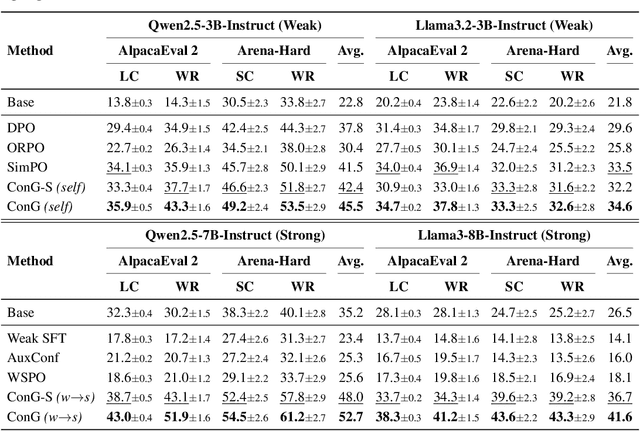
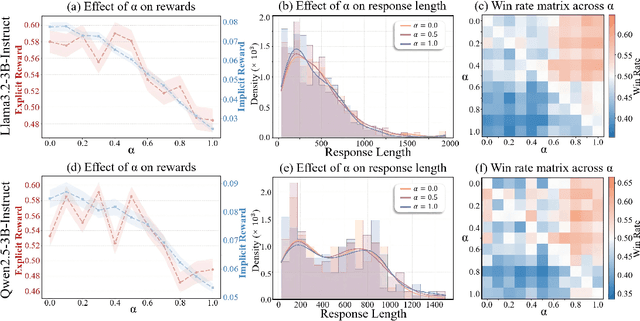
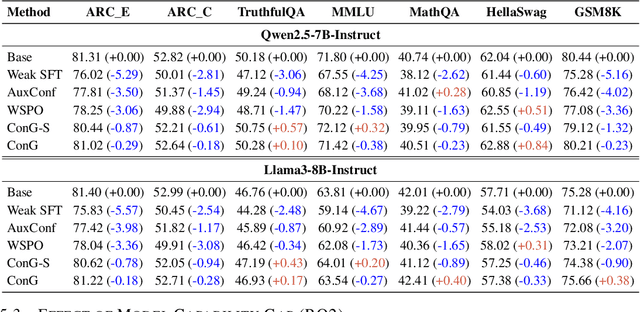
Abstract:Weak-to-strong generalization provides a promising paradigm for scaling large language models (LLMs) by training stronger models on samples from aligned weaker ones, without requiring human feedback or explicit reward modeling. However, its robustness and generalization are hindered by the noise and biases in weak-model outputs, which limit its applicability in practice. To address this challenge, we leverage implicit rewards, which approximate explicit rewards through log-likelihood ratios, and reveal their structural equivalence with Contrastive Decoding (CD), a decoding strategy shown to reduce noise in LLM generation. Building on this connection, we propose Contrastive Weak-to-Strong Generalization (ConG), a framework that employs contrastive decoding between pre- and post-alignment weak models to generate higher-quality samples. This approach enables more reliable capability transfer, denoising, and improved robustness, substantially mitigating the limitations of traditional weak-to-strong methods. Empirical results across different model families confirm consistent improvements, demonstrating the generality and effectiveness of ConG. Taken together, our findings highlight the potential of ConG to advance weak-to-strong generalization and provide a promising pathway toward AGI.
AutoQual: An LLM Agent for Automated Discovery of Interpretable Features for Review Quality Assessment
Oct 09, 2025
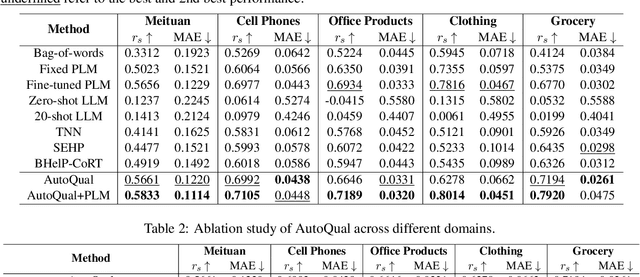
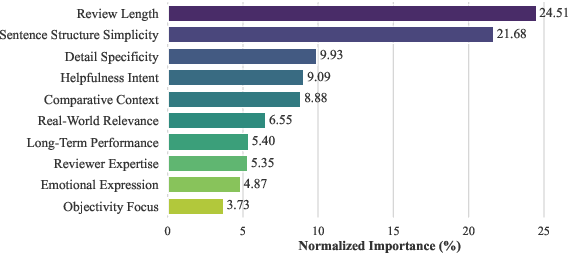
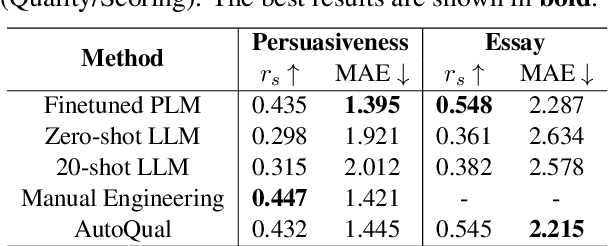
Abstract:Ranking online reviews by their intrinsic quality is a critical task for e-commerce platforms and information services, impacting user experience and business outcomes. However, quality is a domain-dependent and dynamic concept, making its assessment a formidable challenge. Traditional methods relying on hand-crafted features are unscalable across domains and fail to adapt to evolving content patterns, while modern deep learning approaches often produce black-box models that lack interpretability and may prioritize semantics over quality. To address these challenges, we propose AutoQual, an LLM-based agent framework that automates the discovery of interpretable features. While demonstrated on review quality assessment, AutoQual is designed as a general framework for transforming tacit knowledge embedded in data into explicit, computable features. It mimics a human research process, iteratively generating feature hypotheses through reflection, operationalizing them via autonomous tool implementation, and accumulating experience in a persistent memory. We deploy our method on a large-scale online platform with a billion-level user base. Large-scale A/B testing confirms its effectiveness, increasing average reviews viewed per user by 0.79% and the conversion rate of review readers by 0.27%.
Fine-Tuning Flow Matching via Maximum Likelihood Estimation of Reconstructions
Oct 02, 2025Abstract:Flow Matching (FM) algorithm achieves remarkable results in generative tasks especially in robotic manipulation. Building upon the foundations of diffusion models, the simulation-free paradigm of FM enables simple and efficient training, but inherently introduces a train-inference gap. Specifically, we cannot assess the model's output during the training phase. In contrast, other generative models including Variational Autoencoder (VAE), Normalizing Flow and Generative Adversarial Networks (GANs) directly optimize on the reconstruction loss. Such a gap is particularly evident in scenarios that demand high precision, such as robotic manipulation. Moreover, we show that FM's over-pursuit of straight predefined paths may introduce some serious problems such as stiffness into the system. These motivate us to fine-tune FM via Maximum Likelihood Estimation of reconstructions - an approach made feasible by FM's underlying smooth ODE formulation, in contrast to the stochastic differential equations (SDEs) used in diffusion models. This paper first theoretically analyzes the relation between training loss and inference error in FM. Then we propose a method of fine-tuning FM via Maximum Likelihood Estimation of reconstructions, which includes both straightforward fine-tuning and residual-based fine-tuning approaches. Furthermore, through specifically designed architectures, the residual-based fine-tuning can incorporate the contraction property into the model, which is crucial for the model's robustness and interpretability. Experimental results in image generation and robotic manipulation verify that our method reliably improves the inference performance of FM.
BrainPro: Towards Large-scale Brain State-aware EEG Representation Learning
Sep 26, 2025Abstract:Electroencephalography (EEG) is a non-invasive technique for recording brain electrical activity, widely used in brain-computer interface (BCI) and healthcare. Recent EEG foundation models trained on large-scale datasets have shown improved performance and generalizability over traditional decoding methods, yet significant challenges remain. Existing models often fail to explicitly capture channel-to-channel and region-to-region interactions, which are critical sources of information inherently encoded in EEG signals. Due to varying channel configurations across datasets, they either approximate spatial structure with self-attention or restrict training to a limited set of common channels, sacrificing flexibility and effectiveness. Moreover, although EEG datasets reflect diverse brain states such as emotion, motor, and others, current models rarely learn state-aware representations during self-supervised pre-training. To address these gaps, we propose BrainPro, a large EEG model that introduces a retrieval-based spatial learning block to flexibly capture channel- and region-level interactions across varying electrode layouts, and a brain state-decoupling block that enables state-aware representation learning through parallel encoders with decoupling and region-aware reconstruction losses. This design allows BrainPro to adapt seamlessly to diverse tasks and hardware settings. Pre-trained on an extensive EEG corpus, BrainPro achieves state-of-the-art performance and robust generalization across nine public BCI datasets. Our codes and the pre-trained weights will be released.
The Thinking Spectrum: An Emperical Study of Tunable Reasoning in LLMs through Model Merging
Sep 26, 2025Abstract:The growing demand for large language models (LLMs) with tunable reasoning capabilities in many real-world applications highlights a critical need for methods that can efficiently produce a spectrum of models balancing reasoning depth and computational cost. Model merging has emerged as a promising, training-free technique to address this challenge by arithmetically combining the weights of a general-purpose model with a specialized reasoning model. While various merging techniques exist, their potential to create a spectrum of models with fine-grained control over reasoning abilities remains largely unexplored. This work presents a large-scale empirical study evaluating a range of model merging techniques across multiple reasoning benchmarks. We systematically vary merging strengths to construct accuracy-efficiency curves, providing the first comprehensive view of the tunable performance landscape. Our findings reveal that model merging offers an effective and controllable method for calibrating the trade-off between reasoning accuracy and token efficiency, even when parent models have highly divergent weight spaces. Crucially, we identify instances of Pareto Improvement, where a merged model achieves both higher accuracy and lower token consumption than one of its parents. Our study provides the first comprehensive analysis of this tunable space, offering practical guidelines for creating LLMs with specific reasoning profiles to meet diverse application demands.
MoveFM-R: Advancing Mobility Foundation Models via Language-driven Semantic Reasoning
Sep 26, 2025Abstract:Mobility Foundation Models (MFMs) have advanced the modeling of human movement patterns, yet they face a ceiling due to limitations in data scale and semantic understanding. While Large Language Models (LLMs) offer powerful semantic reasoning, they lack the innate understanding of spatio-temporal statistics required for generating physically plausible mobility trajectories. To address these gaps, we propose MoveFM-R, a novel framework that unlocks the full potential of mobility foundation models by leveraging language-driven semantic reasoning capabilities. It tackles two key challenges: the vocabulary mismatch between continuous geographic coordinates and discrete language tokens, and the representation gap between the latent vectors of MFMs and the semantic world of LLMs. MoveFM-R is built on three core innovations: a semantically enhanced location encoding to bridge the geography-language gap, a progressive curriculum to align the LLM's reasoning with mobility patterns, and an interactive self-reflection mechanism for conditional trajectory generation. Extensive experiments demonstrate that MoveFM-R significantly outperforms existing MFM-based and LLM-based baselines. It also shows robust generalization in zero-shot settings and excels at generating realistic trajectories from natural language instructions. By synthesizing the statistical power of MFMs with the deep semantic understanding of LLMs, MoveFM-R pioneers a new paradigm that enables a more comprehensive, interpretable, and powerful modeling of human mobility. The implementation of MoveFM-R is available online at https://anonymous.4open.science/r/MoveFM-R-CDE7/.
Secure Multicast Communications with Pinching-Antenna Systems (PASS)
Sep 19, 2025Abstract:This article investigates secure multicast communications in pinching-antenna systems (PASS), where pinching beamforming is enabled by adaptively adjusting pinching antenna (PAs) positions along waveguides to improve multicast security. Specifically, a PASS-based secure multicast framework is proposed, in which joint optimization of transmit and pinching beamforming is conducted to maximize the secrecy multicast rate. i) For the single-group multicast scenario, an alternating optimization (AO) framework is employed, where the pinching beamformer is updated via an element-wise sequential optimization method. The transmit beamformer is designed via a semidefinite relaxation (SDR) formulation for an upper-bound solution, while a Dinkelbach-alternating direction method of multipliers (ADMM) offers a low-complexity alternative. ii) For the multi-group multicast scenario, transmit and pinching beamformers are alternately optimized under a majorization-minimization (MM) framework. The transmit beamformer is obtained via SDR or an efficient second-order cone programming (SOCP) method, while the pinching beamformer is updated through MM-based element-wise sequential update strategy. Numerical results are provided to demonstrate that: (i) PASS consistently outperform conventional fixed-location antenna architectures in terms of secrecy performance across various configurations; and (ii) the performance advantage of PASS over fixed-location architectures becomes more significant with increased service region, larger antenna arrays, and higher user and eavesdropper densities.
Rationality Check! Benchmarking the Rationality of Large Language Models
Sep 18, 2025Abstract:Large language models (LLMs), a recent advance in deep learning and machine intelligence, have manifested astonishing capacities, now considered among the most promising for artificial general intelligence. With human-like capabilities, LLMs have been used to simulate humans and serve as AI assistants across many applications. As a result, great concern has arisen about whether and under what circumstances LLMs think and behave like real human agents. Rationality is among the most important concepts in assessing human behavior, both in thinking (i.e., theoretical rationality) and in taking action (i.e., practical rationality). In this work, we propose the first benchmark for evaluating the omnibus rationality of LLMs, covering a wide range of domains and LLMs. The benchmark includes an easy-to-use toolkit, extensive experimental results, and analysis that illuminates where LLMs converge and diverge from idealized human rationality. We believe the benchmark can serve as a foundational tool for both developers and users of LLMs.
 Add to Chrome
Add to Chrome Add to Firefox
Add to Firefox Add to Edge
Add to Edge